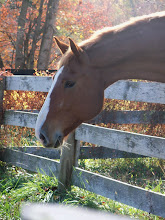Read Your Horse's Mind
Josh Lyons shows you the way to correct a horse's thought before he takes a wrong step

Josh explains the thought vs. action principle at a recent clinic - read the horse's body language from the saddle to improve his action.
Why can the best competitors get their horses in and out of the show ring without a single mistake while our horses cut the corners when we ride in the arena or won't stand still when we mount them?
The flip answer is that the show horse costs much more money than our trail companion, but that's not really the reason. The most expensive, well-trained horse can make a mistake if the rider corrects the horse's action instead of the horse's thought. Those performance riders who learn to correct the horse's thought before the thought becomes a mistake are the ones who win, and you can use that principle in every facet of your own riding.
Josh Lyons says that learning to correct your horse's thought instead of his action-actually reading his mind-will improve anybody's riding, no matter their level.
It's like learning to drive a car. When you first get behind the wheel, you're concentrating on all the things you have to do, from how to steer to where the gas and brake pedals are and when to use the turn signals. Later you move from just trying to get the car to do what you want to anticipating traffic. You see that another driver isn't looking at you, and so you brake for him even before he darts out in front of you.
You probably already do this with your horse to some extent, especially on the ground. If you go in to feed your horse and he pins his ears, you know that he's starting to get aggressive. You'll take steps to correct the aggression before it becomes a bite
or a kick.
or a kick.
"We know how to read body language when we're on the ground," Josh said. "But what we don't do is read it when we're in the saddle. In the saddle, all we ever care about is the action. We really should be focusing on the horse's thoughts because the better we understand his thinking, the better the action becomes."
When a performance rider corrects a horse's thought, you don't see an incorrect action.
"You might see someone working down the rail and see them correct the horse," Josh said. "But you really don't know why they corrected him because the horse looked like he was performing fine. What they corrected was the thought. They didn't have to correct the action because they had already corrected the thought, and the action is a direct reflection of that thought. The action can only be as good as the thought behind it."
Josh compares it to asking a person to stand. If you simply ask him to stand up, he'll do it in a completely different way than if you told him you'll give him $10 to stand up.
"Both times I got him to stand up, but the second time I took into account his thinking process and that's what made the action better," Josh explained. "It wasn't that I said, 'Stand up faster.' I said, 'Be excited to stand up.' I concentrated on his thought, and the thought is what directly affected the action."
To correct your horse's thought, you need to change the way you think. Instead of reacting to your horse's action, you should consider why he's doing it.
"Instead of just focusing on a right turn, for example, think about how the horse is doing the right turn," Josh said. "What's he thinking about while doing that right turn? Is he thinking about trying to go back to the barn? Is he thinking about getting to his buddy horse? Does he want to get back to the gate? If he's not making that turn for the reason you want him to, then you have to make your reason more important to him."
Loretta
the natural horseman
clear communication/visible results







